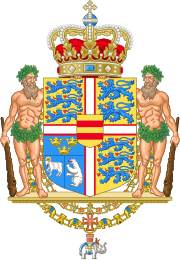
Back Administratiewe streke van Denemarke Afrikaans Rannvroioù Danmark Breton Regije Danske BS Regions de Dinamarca Catalan Danmarks regioner Danish Region (Dänemark) German استانهای دانمارک Persian Tanskan alueet Finnish Regiónir í Danmark Faeroese Région (Danemark) French
| Regions of Denmark Regioner (Danish) | |
|---|---|
| Location | Kingdom of Denmark |
| Number | 5 (as of January 1, 2021) |
| Government |
|
| Subdivisions |
|
 |
|---|
The five Regions of Denmark (Danish: regioner) were created as administrative entities at a level above the municipalities and below the central government in the public sector as part of the 2007 Danish Municipal Reform, when the 13 counties (amter) were abolished. At the same time, the number of municipalities (kommuner) was cut from 270 to 98. The reform was approved and made into a law by the lawmakers in the Folketing 26 June 2005 with elections to the 98 municipalities and 5 regions being held Tuesday 15 November 2005.
Each region is governed by a popularly elected regional council with 41 members, from whom the regional chairperson is chosen.
The main responsibility of the regions is healthcare. Lesser powers of the regions include public transport, environmental planning, soil pollution management and some coordination of secondary education.
In contrast to the former counties (1970–2006), the regions do not have municipal powers. Regions cannot levy taxes, but are financed partly by block grants from the central government (until 2018 sundhedsafgift, i.e. health tax) and partly by taxes collected by their constituent municipalities. Regions cannot decide their budgets independently, but must use the block grant for the purposes that are specified by the central government. In other words, the regional powers were dramatically reduced in favor of the local level. As they are not municipalities, regions are not allowed to have coats of arms, but they do have modern logos.
The small archipelago of Ertholmene to the northeast of Bornholm is not part of any region or municipality. Its inhabitants do not pay municipal taxes, nor did they pay the central government's health care contribution tax (2007 until 2018) or the tax levied by counties prior to 2007.
The representative organisation Danske Regioner was set up on 23 March 2006. It is an advocacy and lobbying organisation speaking on behalf of all of the regions, including negotiating labour contracts, etc. The organization also maintains an office in Brussels (as did its predecessor, Amtsrådsforeningen). As a central representation of the Danish healthcare system, it has rather large, although unofficial, powers. Its equivalent before 2006 was Amtsrådsforeningen (ARF), the organisation of county representations, which had a comparatively larger power.
© MMXXIII Rich X Search. We shall prevail. All rights reserved. Rich X Search
